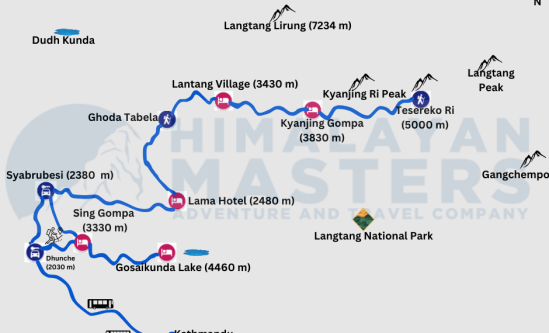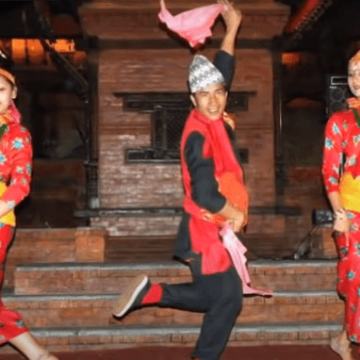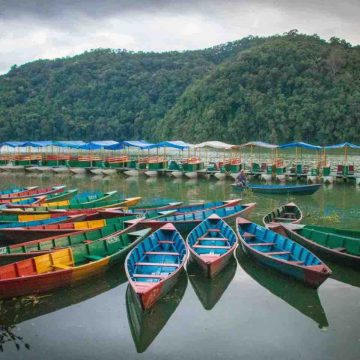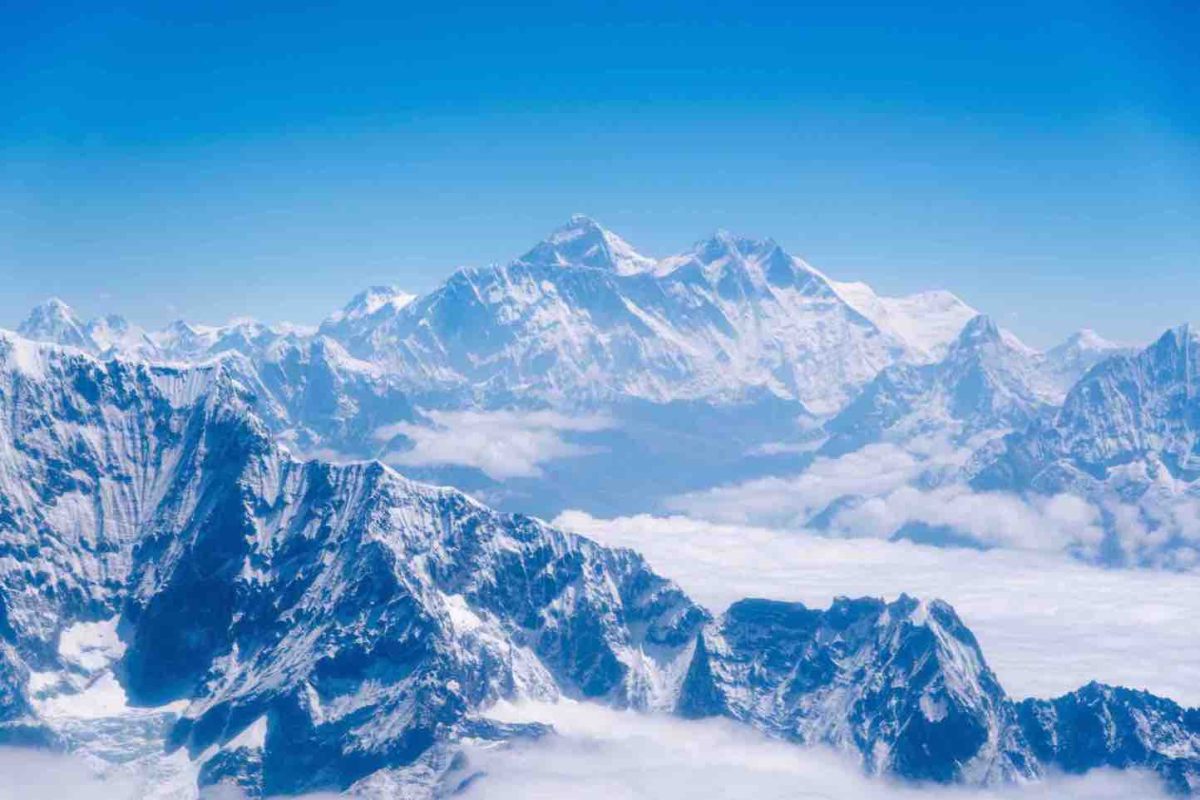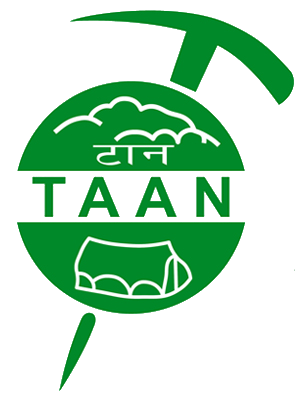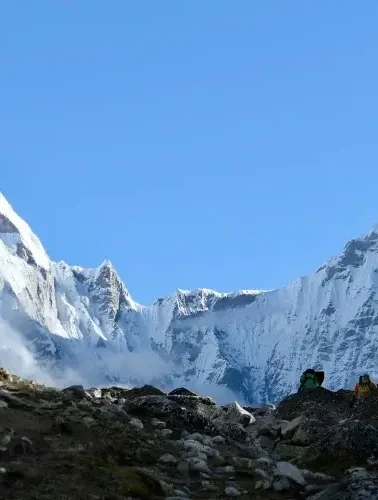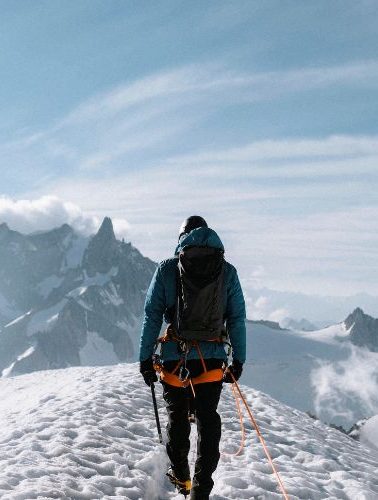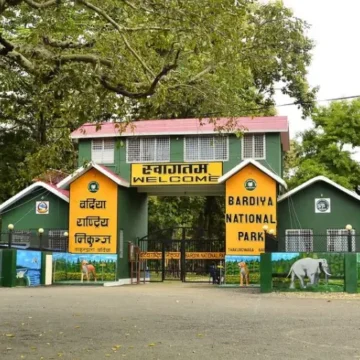
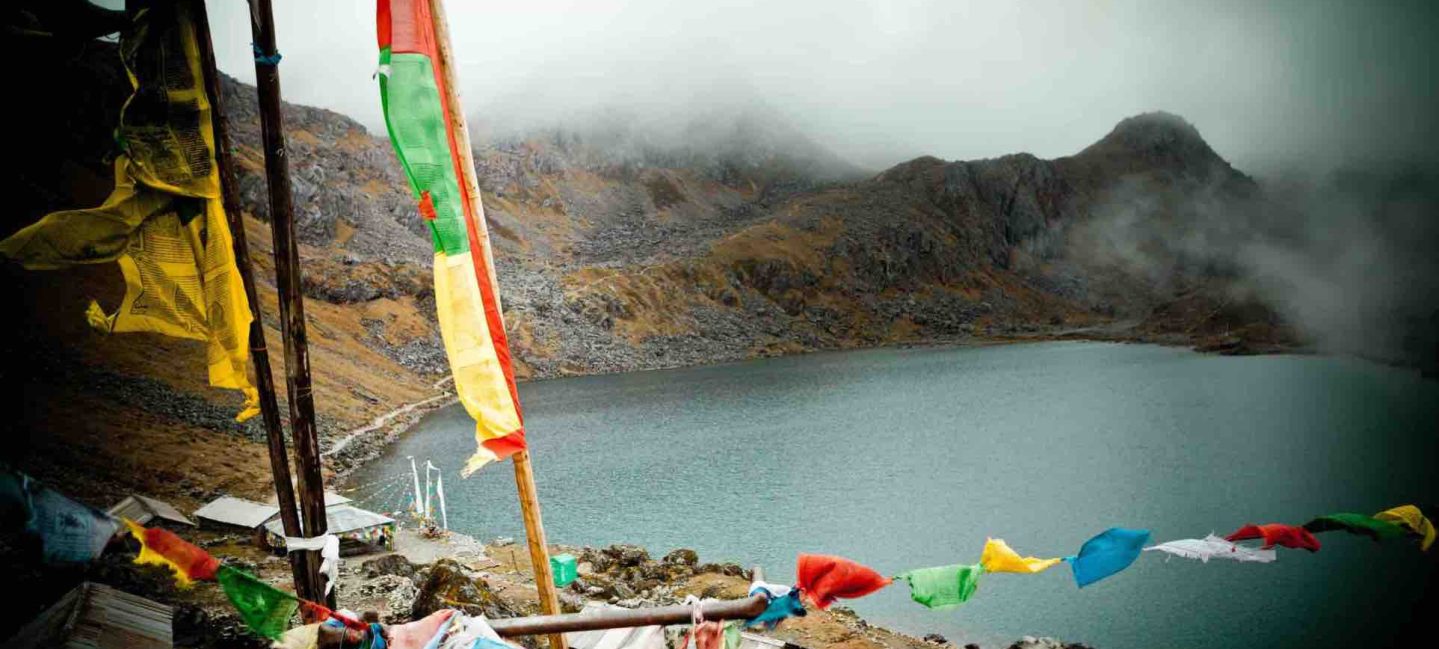
- TRIP DURATION
- 14 Days
- MAX. ALTITUDE
- 4962
- TRIP GRADE
- Moderate
- LODGING
- Tea house
- BEST SEASON
- Springs and autumn
- MEALS
- Breakfast lunch dinner
- COMMUNICATION
- Local sim card
- PER DAY WALK
- 5 to 6 hours
Langtang Gosainkunda Trek- 14 days
Highlight of Langtang Gosainkunda Trek
- Visit Gosainkunda Lake-Hindu’s and Buddhist most excellent pilgrim site
- Witness over dozens of mountain peaks in the Langtang region of Nepal
- Understand the great Buddhist culture and history of Langtang
- Explore the unique Himalayan landscape, incredible bio-diversity, and unique wildlife of Nepal
Overview of Gosaikunda Trek
Who doesn’t love an amalgamation of easy but naturally and culturally delightful treks within a short time? If you are looking for the best tours to the beautiful pristine lake, scenic mountains, unique landscape, and culturally blessed villages, this Langtang Gosainkunda Trek is just your type. Get ready to have an excellent memory.
This Langtang Gosainkunda Trek has been underrated for a century. This is a beautiful tea house trekking experience close to the capital to Gosainkunda, a holy lake for Buddhist and Hindu pilgrimage. Over centuries, Nepalese people have set an arduous journey to this sacred lake, and now it’s open to the public. In August, during Janai Purnima, thousands of people are praying here. Besides the lake, you get to walk via the villages of Langtang and Kyanjin Gompa for a deep insight into the Tibetan Buddhist culture.
Langtang Gosainkunda Trek begins with a drive north of the capital, i.e., Syabru Besi village. From here, we get to the Lama Hotel and Mundu before climbing to Kyanjin Gompa. After a day here, we get back to Syabru Besi and then climb to Sing Gompa. Finally, we get to the beautiful settings of Gosainkunda Lake before getting back to Kathmandu.

Things to see in Gosaikunda Trek
We witness over a dozen mountain peaks during the trek, including Langtang Lirung, Langsisa, Dorje Lakpa, Langtang Ri, Ganjala Peak, and more. Next, we will also witness an incredible bio-diversity of sub-tropical and arid vegetation within a diverse landscape. The wild animals in the region make your tour even more enjoyable. Also, we will see the monasteries, stupas, mani walls, rotating wheels, and a lot of Buddhist cultural events. And obviously, Gosainkunda Lake in the main highlight of the famous Gosaikunda Trek.
History of Gosaikunda Lake Trek
Gosaikunda Lake is a sacred lake situated at the height of about 4380m in the Langtang National Park, Nepal, and is very famous among Hindus and Buddhists. It is believed that Lord Shiva dug out the Holy Water Lake by his trident, known as Trishul, to quench his thirsty throat after consuming poison during the Samudra Manthan to obtain the click of immortality named Amrita.
The lake and its vicinity are referred to in the Ramayana and the Mahabharata, which means that the place has a religious significance. During the festival of Janai Purnima held in the August, thousand of pilgrims from Nepal and India walk through a tough track to reach Gosaikunda to take bath in its freezing water believing that whoever does so washes away sins from his/her soul.
Historically, Gosaikunda has also been important as a water source. As well as a halt on old trading routes through the Himalayas from Nepal to Tibet. It has become one of the top most trekking destinations as enthusiasts. Spiritually inclined individuals are pulled by its tranquility, serenity and vistas of the Himalaya Mountains. But in the recent years, this trek has apparently assumed its religious and historical importance along with the geographical splendor of the natural beauty of the high altitude, varieties of flora and fauna. The cultural interactions with the local inhabitants of the Tamang and Sherpa origin on the trek.
Read other Nepal Hiking packages
ITINERAY
Day 01: Arrival at kathmandu
Altitude: 1400 meters
Welcome to Kathmandu, the gateway to the Himalayas! After a long flight, you’ll be greeted by our representative at Tribhuvan International Airport (TIA). Kathmandu is a vibrant city with a rich history and culture.
The afternoon is yours to relax and unwind. This is a good time to get your bearings in the city, grab a delicious meal at one of the many local restaurants, or maybe even explore the nearby Thamel district, known for its vibrant nightlife and diverse shops.
In the evening, we’ll all meet for a welcome dinner. This is a chance to get acquainted with your fellow trekkers and experienced guides. They’ll share valuable insights about the trek and answer any questions you have.
Overnight in Kathmandu
Accomodation : Hotel
Day 02: Drive to Syabru Besi from Kathmandu
Altitude: 1,600 meters
Now, it’s time to head towards the Mountains. So, an early morning ride takes us along the hilly, winding road of Nepal. Beyond many small settlements, rivers, and waterfalls, we get to Syabru Besi. Here, you get to live a day in a local hotel and get ready for a fantastic journey ahead.
As you ascend, the air gets crisp and clean. You’ll see breathtaking views of the terraced hillsides, where locals have carved out their homes and farms amidst the steep slopes. We’ll stop for lunch at a local restaurant along the way, allowing you to experience the local cuisine and interact with friendly locals. The food will be simple but delicious, featuring traditional Nepali dishes.
In the late afternoon, we’ll reach Syabru Besi, a small village that serves as the starting point for our Langtang trek. Syabru Besi is a charming village, with a relaxed atmosphere and friendly locals.
Tea House: (Several teahouses are available in Syabru Besi. Some popular options include Hotel Langtang, Syabru Besi Lodge, and Yeti Lodge. They offer basic but comfortable accommodations with delicious meals).
Overnight in Syabru Besi
Meal : Breakfast/ Lunch/ Dinner
Accomodation : Tea House
Walking / Driving : 7-8 hours
Day 03: Trek to Lama Hotel
Altitude: 2,470 meters
Duration: 10.9kms

Our initial trekking journey begins from Syabru Besi. In the morning, we walk to a bridge over the Langtang River. Then, we pass via the sub-tropical forest of Rhododendron, Pine, and Bamboo. Climbing slowly above the river, our days end at the Lama Hotel.
We’ll have our first glimpse of the majestic Langtang Lirung, the highest peak in the Langtang range. You’ll also see other impressive peaks in the distance, including the Ganesh Himal range.
The trail climbs steadily, but the scenery is well worth the effort. We’ll stop for lunch at a beautiful spot along the river, enjoying a picnic-style lunch with views of the mountains.
In the afternoon, we’ll continue our trek, eventually arriving at Lama Hotel, a quaint village nestled amidst the towering peaks.
Tea House: (Lama Hotel has a few teahouses offering basic but comfortable accommodation. Some options include Lama Lodge, Langtang View Guest House, and Hotel Langtang Lama Hotel. They offer stunning views of the surrounding mountains).
Also read another route here Helambu Trekking Nepal.
Overnight in Lama Hotel
Meal : Breakfast/ Lunch/ Dinner
Accomodation : Tea House
Walking / Driving : 5-6 hours
Day 04: Trek to Langtang Village
Altitude: 3,430 meters
Duration: 14.8 km

This is a short and exciting walk to the Langtang Village. Walking with stunning Mt. Langtang Lirung before us, we first get to Ghora Tabela. Entering the Langtang National Park, we witness more amuses of Langtang. However, as we enter the Langtang Village, the impact of the 2015 earthquake will be visible.
You’ll walk through a mix of landscapes, including lush forests, open meadows, and rocky trails. Keep an eye out for colorful wildflowers blooming along the way, adding to the vibrant scenery.
We’ll reach Ghoda Tabela, a small settlement, before entering the Langtang National Park. This is a good spot to stop for a break and take in the panoramic views.
The trail continues through the park, and as you approach Langtang Village, you’ll begin to see the impact of the 2015 earthquake. The village was severely affected, and you’ll witness the ongoing rebuilding efforts.
Despite the destruction, the spirit of the Langtang Village people is strong. They’re rebuilding their homes and lives, and you’ll see a sense of community and resilience that’s inspiring.
Tea House: (Langtang Village offers several teahouses to choose from. Some popular options include Langtang Lodge, Langtang Village Guest House, and Hotel Langtang Village. They provide comfortable lodging and delicious food).
Overnight in Langtang Village
Meal : Breakfast/ Lunch/ Dinner
Accomodation : Tea House
Walking / Driving : 4-5 hours
Day 05: Trek to Kyanjin Gompa
Altitude: 3,870 meters
Duration: 6.8 km
Today, we walk via many villages, yak pastures, and streams to Kyanjin Gompa. This white-washed old monastery of Langtang holds great significance to the people of Langtang.
The trail follows the Langtang Khola (river), and you’ll see the river rushing alongside you as you trek. This is a popular spot for spotting wildlife, so keep your eyes peeled for yaks, blue sheep, and various bird species.
As you ascend, the views become even more impressive. You’ll see the majestic Langtang Lirung towering above the valley, with other peaks surrounding you.
We’ll reach Kyanjin Gompa, a picturesque village with a white-washed monastery. The gompa (monastery) is an important site for the local Buddhist community and is a great place to learn about Tibetan Buddhist culture.
Tea House: (Kyanjin Gompa offers a few teahouses, providing comfortable accommodation with amazing views. Some popular options include Kyanjin Gompa Lodge, Langtang Lodge, and Tserko Ri Lodge. You’ll also find several small shops and restaurants in the village).
Overnight in Kyanjin Gompa
Meal : Breakfast/ Lunch/ Dinner
Accomodation : Tea House
Walking / Driving : 2-3 hours
Day 06: Rest day and hike to Tserko Ri
Altitude: 5,000m
Our plan for the day is to hike up to Tserko Ri in the morning. This hilltop lies at 5000 meters above sea level, and the sunrise from the top looks mesmerizing. It’s also the best viewpoint for the panorama of Langtang Himal.
As there are no teahouses or lodges on the way to Tserko Ri, we must pack our lunch and water. Make sure to carry enough snacks and water for energy. The route is all the way uphill as we will climb Tserko Ri. After exploring the peak and seeing the mesmerizing view of Langtang, Langtang Lirung, Shishapangma, and many other peaks, we will make our way down to Kyanjin Gompa.
We explore the Kyanjin Gompa in the evening and learn more about Buddhist culture.
Overnight to Kyanjin Gompa
Meal : Breakfast/ Lunch/ Dinner
Accomodation : Tea House
Walking / Driving : 7 hours (round trip)
Day 07: Trek to Lama Hotel
Altitude: 3,430 meters
So, now we plan to trace the same route back to Lama Hotel. On the way to Lama Hotel, we will have the Langtang Khola walking along with us. During the spring season we can see the beautiful forest of rhododendrons all over the way. Then we will reach Langtang Village after walking for an hour.
Then we will reach Ghoda Tabela where we will have our lunch. After resting for a while, we will move towards the riverside, a teahouse area along the shore of the river. It has one of the majestic jungles and river views. On the way down, we might spot some wild animals and birds.
We reach Lama Hotel by night and stop here. We will stay at the same hotel where we stayed during the trek before.
Overnight in Lama Hotel
Meal : Breakfast/ Lunch/ Dinner
Accomodation : Tea House
Walking / Driving : 6 hours
Day 08: Trek to Syabru Besi
Altitude: 2,230 meters
Duration: 13.1 km
Today, we’ll continue our descent, hiking back to Syabru Besi. The trail is the same one we took on our way to Lama Hotel, but we’ll be going downhill, making it a relatively easy trek. Earlier in the trek we had stayed in Syarbrubesi but this time we will stay at Thulo Syarbru.
We will make our way down to bamboo. Then after crossing the river, we will move towards a place called Pahiro. Pahiro means landslide in Nepali language. The place is named Pahiro because the place is prone to landslides. We will have our lunch at Pahiro. There are around 3 teahouses in Pahiro. There is also one small hot spring near Pahiro known as Tatopani.
As we descend, the air will get warmer, and the vegetation will become denser. You’ll see a variety of trees and flowers, and you might even spot some wildlife along the way.
Then after hiking for more than 2 hours, we will reach our destination, Thulo Syarbru.
About Thulo Syabrubesi: Thulo Syarbrubesi is a small village located in the Langtang National Park of Nepal. You will find schools, health posts, police posts, and national Park check posts. There are around 50-60 local houses of people excluding the teahouses. Most of the people are engaged in tourism. The major source of income for the people is either tourism or agriculture.
Teahouse of Thulo Syabrubesi:
– Around 10-15 teahouses.
– Have a good facility of accommodation.
– Attached bathrooms, Wifi, electricity, hot shower.
Overnight in Syabru Besi
Meal : Breakfast/ Lunch/ Dinner
Accomodation : Tea House
Walking / Driving : 6-7 hours
Day 09: Trek to Sing Gompa
Altitude: 3,330 meters
Duration: 6.8 km
The trail will take us through a mix of landscapes, including lush forests, open meadows, and rocky trails. You’ll pass through the small village of Thulo Syabru Besi and continue on to the villages of Dursagang and Phoparng Danda, allowing you to experience the beauty of the Tamang culture. There are around 2 teahouses in this area. After hiking for 3-4 hours you will reach there. The route is all the way uphill.
As we hike, we’ll have magnificent views of the Ganesh Himal range, a stunning cluster of peaks in the distance. The air will be crisp and clean, and the silence of the mountains will be broken only by the sound of the wind through the trees.
We’ll reach Sing Gompa in the late afternoon, a small village nestled in a beautiful valley. Sing Gompa is a traditional Tamang village, known for its Buddhist monastery and a local cheese factory. You can explore the village and learn about the local culture.
Teahouses in Sing Gompa:
– Good services of Wfi, electricity, hot shower.
– Around 4-5 teahouses.
Overnight in Sing Gompa
Read all Langtang Trek Guide
Meal : Breakfast/ Lunch/ Dinner
Accomodation : Tea House
Walking / Driving : 5-6 hours
Day 10: Trek to Gosainkunda Lake
Altitude: 4,460 meters
Duration: 11.2 km

Get excited for the incredible journey of your life. First, we will pass through Cholang Pati after walking a steep ascent for 2 hours. Some people even have lunch here.
As we walk above Lauri Binayak, we can witness a significant change in the landscape. After 1.5 hours walk we will reach here. This is known as one of the best viewpoints for eye grasping view. You can have a view of Tamanag Heritage Trail, Langtang Valley, Annapurna, and so on.
Seeing the view of Langtang Lirung beyond the valley. Then after having lunch and walking for 2 hours, we will reach our dream destination. The route is equal ascents and descents. While reaching Gosaikunda you will find various lakes along the way. Some are Bhairav lake, Kaalo Lake.
Then we get to the holy lake of Gosainkunda. This sacred lake created by Lord Shiva is our stop for the night.
About Gosaikunda: Gosaikunda Lake is a beautiful mountain lake in the Langtang National Park of Nepal. Located at 4,380 meters high, it is surrounded by tall, rugged mountains. This lake is important to both Hindus and Buddhists, attracting many pilgrims, especially during the Janai Purnima festival in August. The clear waters, peaceful surroundings, and spiritual feel make Gosaikunda Lake a special place to visit for trekkers and pilgrims alike.Top of FormBottom of Form
Teahouse of Gosaikunda:
– Around 4-5 teahouses with basic facilities.
– During peak season you might have to sleep in the dining room.
– Bucket shower available since there is no electricity.
Overnight in Gosainkunda Lake
Meal : Breakfast/ Lunch/ Dinner
Accomodation : Tea House
Walking / Driving : 4-5 hours
Day 11: Trek to Sing Gompa or Chandan Bari
Altitude: 3250 meters
In the morning, we explore the magnificent areas of Gosainkunda Lake and Surya Peak. We will make our way down to Sing Gompa. You will pass through the holy lakes and forests. The route has steep inclines.
About Sing Gompa: Sing Gompa, also known as Chandanbari, is a small village in the Langtang region of Nepal. It is famous for its old Buddhist monastery, Sing Gompa, which is important to local people. The village offers beautiful views of the mountains and has a yak cheese factory where you can try and buy tasty yak cheese. Sing Gompa is a great place for trekkers to rest, with cozy lodges and a peaceful environment, making it a nice stop on the way to Gosaikunda Lake.
Overnight in Chandan Bari or Sing Gompa
Meal : Breakfast/ Lunch/ Dinner
Accomodation : Tea House
Walking / Driving : 4-5 hours
Day 12: Trek to Dhunche
Altitude: 2,030 meters
This is your last day for the trek. Walking beyond the forest, we witness more langur monkeys and Himalayan animals. First, we get to Sing Gompa Stream and cross it on a suspension bridge. Then, we hike to the village of Dhunche, where we stop at the tea house for one last time.
About Dhunche: Dhunche is a small town in the Langtang region of Nepal and serves as the headquarters of Rasuwa District. It is the starting point for many treks, including the Langtang Valley and Gosaikunda Lake treks. Located at an altitude of about 1,965 meters, Dhunche offers stunning views of the surrounding mountains. The town has basic facilities like guesthouses, shops, and restaurants, making it a convenient place for trekkers to prepare for their journey. Dhunche also hosts schools, a hospital, a check post, and many government departments, providing essential services to both locals and visitors. With a friendly local community and a peaceful atmosphere, Dhunche is a pleasant stop before heading into the mountains.
Teahouse at Dhunche:
– There are around 10-15 teahouses.
– Cost may be a bit more expensive than other places.
– Can find standard to basic lodges.
– Wifi, Hot shower, electricity, attached bathroom everything can be found.
Overnight in Dhunche
Meal : Breakfast/ Lunch/ Dinner
Accomodation : Tea House
Walking / Driving : 6 hours
Day 13: Drive to Kathmandu
Altitude: 1400 meters
Driving time: 7 to 8 hours
The drive to Kathmandu starts in the early morning. Driving via many terraces, streams, and rivers, we get to witness the best of Nepal. Back to the hotel, you will have some time for the souvenir shopping. Then, you will all gather for a farewell dinner, sharing beautiful memories of the trip.
Overnight in Kathmandu
Accomodation : Hotel
Day 14: Departure
Now, it’s time to get back to the airport and catch and next plane home. So, we drive you to the airport a few hours before your scheduled time, and then you fly away with the beautiful memories of Nepal. Hope you have a great journey ahead.
Well, you will obviously have a memorable journey in Langtang Gosainkunda Trek. However, if you wish to make it luxurious and affordable without having to worry about permits and hotels, we are here to help you. Do contact us or leave a comment below.
useful info
Langtang Gosaikunda Trek Difficulty
Altitude of Langtang Gosaikunda Trek
The Langtang Gosaikunda Trek takes you to higher altitudes. The maximum height is Gosaikunda Lake, which is approximately 4380m/14370ft. The Gosaikunda Trek starts from Syabrubesi, about 1,550 meters (5,085 feet) above sea level. You can get altitude sickness while you are high, so it is advised that you get used to it gradually.
Walking
This Langtang Gosaikunda trek has moderate to strenuous levels of difficulty in physical activities. Each day, a total of 5 to 7 hours of walking is done, corresponding to the 10 to 15 kilometres of walking distance. This could make the trek rather strenuous for some people since the paths, at times, are flat and steep up or down a hill. Sections around Gosaikunda Langtang Trek are comparatively rocky and complex in terms of pathways.
Climate of Gosaikunda Trek
The Langtang Gosaikunda weather may be unpleasant most of the time, especially during the season. The recommended months to visit Gosaikunda Lake are March to May and September to November for relatively mild, cool, dry weather. Winter is cold and freezing, especially in the highlands; snow makes the terrain slippery and sometimes icy.
Langtang Gosaikunda Trek Route
The terrain is varied, and it passes through forests, alpine meadows, and high-altitude lakes. Syabrubesi Lama Hotel is the first destination of the trek, followed by Langtang Village, Kyanjin Gompa, and then Gosaikunda Lake. This means that the trails may be complicated. In some areas, they are steep, and in some areas, they are narrow, thus calling for caution when making steps. This is especially true traversing the Lauribina Pass, which stands at 4,610 meters or 15,120 feet since the climb and the descent are very steep.

Trip Grade: Fitness level, Medical, and Health
Langtang Gosaikunda Trek is moderate that is why to go for the trek one must have to be in average physical condition. On average, the trekkers are able to complete around 5 to 6 hours km of the trail a day, with about 300 meters up and down and it involves having a 5kg backpack at most.
Of course, one must acknowledge rounding issues which per se are the major concern throughout the trek given the altitude of above 4000 meters. To avoid this from happening, trekkers are usually provided with some days in which they would have to spend most of their time resting and visiting some of the sites around the area.
The other is to carry along a simple supply kit and some useful items such as bandages, an anti-bacterial cream, and minor petty medical kits for altitude sickness.
Altitude Sickness in Langtang Valley and Gosaikunda trek
Altitude sickness is a common concern on the Gosaikunda trek, which reaches a high point of about 4,380 meters (14,370 feet). Starting from Dhunche at around 1,950 meters (6,400 feet), trekkers gradually ascend to higher altitudes, passing through places like Chandanbari (3,330 meters) and Lauribinayak (3,910 meters).
The rapid gain in altitude can lead to symptoms of altitude sickness, such as headaches, nausea, dizziness, and fatigue. It’s important to acclimatize properly by taking regular breaks, staying hydrated, and ascending slowly.
Trekking Experience of Langtang Gosaikunda trek
Trekking is relatively challenging; thus, this trek is best suited for advanced trekkers; however, it’s not necessary that prior trekking experience is compulsory. Regarding the trek, anyone with an illness, a pregnant woman, or anyone with a problem who cannot do a lot of climbing up and down steep and rough terrains in mountainous areas should not go for the trek. But as long as one has a positive attitude towards the entire process and has the right information on the trek, a first-time trekker never has to go through any of the staking and gets through this trek with a guide.
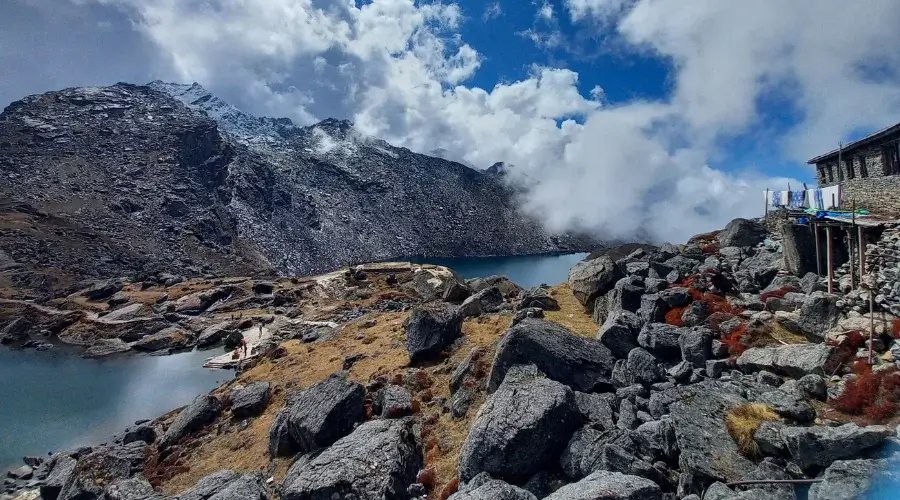
Emergency and Evacuation
Thus, on the Langtang Gosaikunda Trek, it might be worthwhile to mention that there are occasions that can be negotiated in order to get help and evacuation in cases of troubleshoots. Several trekking companies offer guided treks and some also avail guides on first aid, and on altitude sickness.
For even more exigent circumstances, a helicopter can be hired; for example; at altitude, travelers may experience sickness which requires them to be evacuated immediately or any other exigent circumstance which necessitates air evacuation.
Kit and equipment for Langtang Gosaikunda Trek
When preparing for the Langtang Gosaikunda Trek, it’s essential to pack the right gear and equipment to ensure a safe and enjoyable journey. Here’s a list of essential items to bring:
Clothing:
- Waterproof and breathable trekking pants
- Insulating layers (fleece jacket, down jacket)
- Moisture-wicking base layers (long-sleeved shirts, thermal underwear)
- Waterproof and windproof jacket
- Trekking socks (wool or synthetic)
- Sun hat and beanie or warm hat
- Gloves or mittens
Footwear:
- Sturdy and comfortable hiking boots with ankle support
- Trekking sandals
Gear:
- Backpack with rain cover (large enough to carry water, snacks, extra clothing, and personal items)
- Sleeping bag suitable for cold temperatures
- Trekking poles for stability and support on uneven terrain
- Sunglasses with UV protection
- Personal water bottle or hydration system
- Quick-drying towel
- Personal toiletries and medications
- Sunscreen and lip balm with SPF protection
- Insect repellent
Miscellaneous:
- Lightweight and quick-drying towel
- Camera or smartphone for capturing memories
- Power bank or portable solar charger
- Trekking permit and identification documents
- Cash
Special training
In training for the Langtang Gosaikunda Trek, stamina must be trained through cardiovascular activities such as walking, running, and cycling, among others. Some of the exercises aim at your legs, core, and upper body strength, including squats and lunges. Gradually increase the frequency of the hikes and the time you use for hiking. If possible, go to high altitudes to get used to the altitude. This is important because one acclimatizes to the load, and stretching exercises are also included to ensure that muscles remain flexible.
Best Time for Langtang valley and Gosaikunda trek
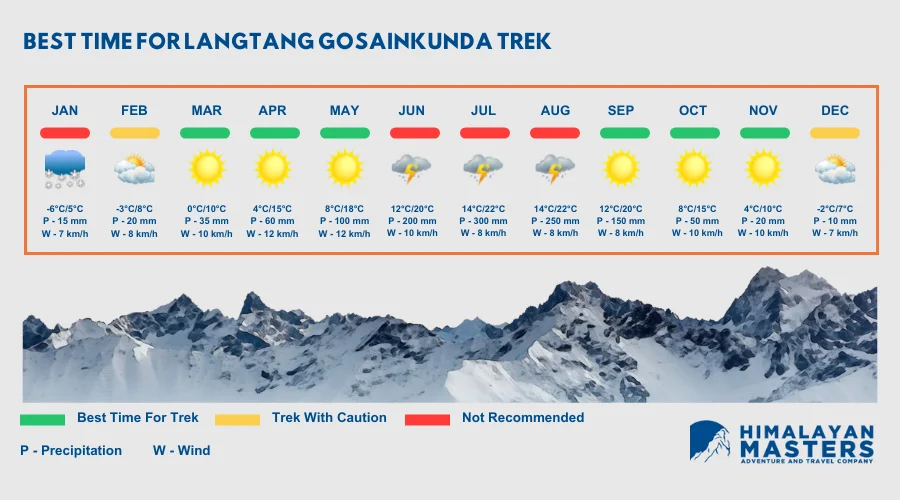
The best time for Langtang Gosaikunda Trek is during the spring (March to May) and autumn (September to November) seasons. These periods have the most favourable weather conditions and stunning natural beauty.
Gosaikunda Trek in Spring (March to May)
Langtang Gosaikunda Trek Weather in Spring:
The spring season on the Gosaikunda Trek is Moderate, with warm to mild temperatures. Trekkers will experience little fluctuating weather throughout the Langtang Gosaikunda Trek. The temperature during the day varies from 10 to 20 degrees Celsius; nights can be colder, especially in the mountains.
The trails are covered with rhododendrons and other flowers, creating a stunning and colourful atmosphere. The sky is generally clear, providing a good view of the Langtang Himal and other snow-capped mountains.
Pros: Trekking appropriate climate, sceneries, vegetation, and mountain views.
Cons: Tour high season means that many trekkers and tourists prefer this period for hiking and visiting the teahouses.
Gosaikunda Trek in Autumn (September to November)
Langtang Gosaikunda Trek Weather in Autumn:
After the monsoon season, Langtang Gosaikunda is warm and has fairly set weather; the skies are clear, giving it good visibility. The daytime temperature is moderate, between 10 and 18 degrees Celsius, and nights can be really cold, particularly at higher altitudes.
The outlook of the mountains is greatly improved. There are clear skies with no pollution at all. As you follow the trail, primarily through villages, it has a cultural aspect, especially because it is harvested during autumn.
Pros: Good weather, remarkable topography.
Cons: Another busy trekking time can sometimes imply an increased number of people on the trails.
Gosaikunda Trek in Winter (December to February)
Langtang Gosaikunda Trek Weather in Winter:
High altitudes and cool temperatures, with daytime temperatures falling between 5 to 10 degrees Celsius and night temperatures considerably low. Higher trails may prove difficult or closed during winter due to snowfall in Gosaikunda.
Winter scenes introduce several aesthetical appeals, especially when snow covers the ground completely. The climate is reasonably dry with much clear weather; the visibility, therefore, is good for the presence of the mountains.
Pros: Fewer visitors, no disturbing noise, and more scenic beauty of snow-capped mountains.
Cons: Severe weather and temperature, the possibility of a great amount of snow, and closed trails.
Gosaikunda Trek in Monsoon (June to August)
Langtang Gosaikunda Trek Weather in Monsoon:
Most of its rainfall occurs through heavy downpours, very high humidity levels, and cloudy weather. Generally, paths can be wrong, turning into marshland, and sometimes, the trails could be clearer. For instance, in Gosaikunda, during the Monsoon season, there is a very high tendency to experience landslides.
Because of the rains, the conditions are slippery and soggy; however, mountainous regions are often hidden from view by mist.
Pros: Lush landscape and less crowd.
Cons: Difficult trekking conditions, leeches, little or no mountain views, and risk of landslides.
Langtang Gosaikunda Helambu trek Permits
You’ll need to obtain two permits for Langtang Gosaikunda Trek, which help manage conservation efforts and ensure safety along the trails.
TIMS Card (Trekkers’ Information Management System): The TIMS card collects trekkers’ information for safety and emergency purposes and monitors trekking activities in the region.
Cost: USD 20 for foreigners, USD 10 for SAARC nationals.
Langtang National Park Entry Permit: This permit is required to enter the Langtang National Park, which covers the majority of the Langtang Gosaikunda Helambu trekking route. It helps fund conservation efforts and infrastructure maintenance within the park.
Cost: USD 30 per person.
Accommodation during the Langtang Gosaikunda trek

Teahouses/Lodges:
Teahouses are the main types of accommodation available along the Langtang Gosaikunda Trek routes. In teahouses, they provide simple beds and blankets in their rooms for tourists. They, as mentioned before, have common facilities like showers and toilets, which have been known to have squat toilets available.
Living areas are also commonly used as living spaces where individuals come together to take their meals. There are often hot showers available at many teahouses for a small extra charge; however, the availability is influenced by the altitude and the relative accessibility of the areas. They are very cheap, costing between 500 to 1500 NRP per night, helping the trekkers spend less.
Camping:
Camping is possible for people who want even less contact with other tourists or are searching for more deserted locations. All carrying camping necessities such as tents, sleeping bags, and kitchen utensils are done by trekkers. Also, some of the teahouses charge a small amount of money for getting to have a camping ground where they may furnish basic needs such as water and, on certain occasions, may allow campers to use some of the bathing facilities in the teahouse.
Food in Langtang Gosaikunda Trek
You can expect a wide range of food while in the Langtang Gosaikunda Trek.
Breakfast:
Choices range from tea or coffee to Tibetan bread, pancakes, porridge, eggs boiled, fried, or made into an omelette or muesli with hot milk.
Lunch:
Some options are Dal Bhat (rice and lentils with curry), Chow mein (noodles), fried rice, pasta, sandwiches (cheese, eggs, or vegetarian), and soups (vegetarian or noodle).
Dinner:
There are similar options to lunch, with additions such as momos (dumplings), pizza, yak steak (in higher altitudes), and occasionally international dishes like spaghetti.
Beverages and Snacks:
Hot drinks like tea, coffee, hot chocolate, soft drinks (Coke, Fanta), bottled water, local alcoholic beverages (beer, Chang), biscuits, chocolate bars, nuts, energy bars, and fresh fruits when available.
Electricity, battery recharge, and water during the Langtang and Gosaikunda trek
Electricity:
- Most teahouses and lodges provide electricity.
- Exceptions include Lama Hotel, where electricity is not available.
- In Gosaikunda, some places may have limited or no electricity, but several teahouses and lodges use solar panels to charge devices and offer basic amenities like Wi-Fi.
Water:
- Trekkers will find numerous water sources, such as streams and taps, at teahouses and lodges throughout the trek.
- Drink by boiling it or using water purification tablets to ensure safety.
- Refilling reusable water bottles is convenient and environmentally friendly, minimizing the use of single-use plastic bottles.
Roads On The Gosaikunda Trek And How To Avoid Them
This trek is rated easy to moderate but can include some routes that can be quite tough for individuals to trek through. Nevertheless, there are several segments where roads, or at least jeep tracks, are present – mostly at the lowest altitudes. Of course, there are opportunities to change direction and return to more typical hiking. The right path enables a tourist to avoid too many roads and instead experience the beauty of the Langtang Gosaikunda region.
Alternative routes for Gosaikunda Trek Nepal
Likewise, the trek to Gosaikunda is also known as Langtang Gosaikunda Trek, but Gosaikunda has many ways. It is the Helambu Trek, which starts from Sundarijal or Chisapani, near Kalika, and takes you through the cultural Helambu trek to Gosaikunda. The other is the culturally rewarding Tamang Heritage Trail, where one can meet the people and even their customs as it connects to Gosaikunda through beautiful, unfamiliar villages. Always carry a Langtang Gosaikunda Trek map for convenience.
With Himalayan Masters
Booking/Airport Pickup:
Himalayan Masters also offer easy-to-book treks like Langtang Gosaikunda Trek, respectively, to make it easier for them even if it’s their first time. They have a good arrival meet and greet service in Kathmandu, and their staff will be waiting for you along with a Nepali welcome and will transfer you to your trekking team.
Support Team:
In such cases, when trekking with Himalayan Masters, you are never alone because you will always be associated with a support crew throughout the trekking exercise. All the guides, porters, and other crew members are professional and will guarantee safety, comfort, and satisfaction throughout the tour.
Starting Point/Ending Point:
Typically the trek to Langtang Gosaikunda starts at Syabrubesi. After getting out of Syabrubesi, eager trekkers can tread into the heaven known as Langtang and Gosaikunda. The trek continues through Syabrubesi after the striking and fun time making stops to capture beautiful scenery and interact with the locals.
A typical day on the Gosaikunda Lake Trek
As with the other treks, a normal Langtang and Gosaikunda trek itinerary begins with waking up early for breakfast from a teahouse or lodge. Trekkers next begin their trek, which is usually early in the morning, around 7-8 AM, where they pass through villages/forests and some beautiful mountains. The break is usually taken in the mid-morning at a teahouse. In the event that a lodge is available in the region, it is also taken in the mid-morning. This tour takes the party less than the morning trek and gets the party to the day’s planned stop in the afternoon or early evening. After the meal, trekkers take a break to charge their energy and sleep a bit before addressing activities to be done the next day.

Langtang Gosaikunda trek cost
The Langtang Gosaikunda Trek cost around $ 1365 per person. Such costs include charges for permits, guides, porters, meals, accommodation, transport, and any other expenses incurred during the tour. However, the following Langtang Gosaikunda trek cost should be noted and are not included in the above calculations: Known mitigation factors are International flights, Travel insurance, and Tips.
Here’s a general breakdown of the costs:
Permits:
Langtang National Park Entry Permit: NPR 3,000 for foreigners, NPR 1,500 for SAARC nationals.
TIMS (Trekkers’ Information Management System) card: NPR 2,000.
Guide and Porter Fees:
Guide: Around NPR 2,000 to 3,000 per day.
Porter: Around NPR 1,500 to 2,500 per day.
Accommodation:
Teahouses and lodges along the trekking route: Approximately NPR 500 to 1,500 per night, depending on the season and location.
Meals:
Three meals a day: Approximately NPR 1,500 to 2,500 daily, including breakfast, lunch, and dinner.
Transportation:
Bus or jeep from Kathmandu to Syabrubesi (starting point of the trek): Around NPR 500 to 1,000 per person, one way.
Miscellaneous:
Water, snacks, and other personal expenses: Approximately NPR 1,000 to 1,500 per day.
Insurance for Langtang Gosaikunda trek
Travel insurance is essential for the Langtang Gosaikunda trek due to its remote and high-altitude wilderness. It covers crucial aspects such as emergency medical evacuation for altitude sickness, accidents, and injuries, as well as trip cancellations and loss of personal belongings. Trekkers should ensure their insurance includes coverage for altitudes up to approximately 4,400 meters, as most insurers provide this level of coverage. Costs for such insurance typically range around $75, depending on coverage limits and the trek duration. A trekker must bring travel insurance from their home country.
Additional Expenses for Gosaikunda Helambu Trek
- Snacks.
- Additional drinks.
- Buying souvenirs during the trek or from the porters.
- Charging electronic gadgets.
- Also, warmth and hot temperatures, such as taking a hot shower.
ATM in Langtang Valley and Gosaikunda Trek
ATM facilities can be available in Kathmandu and sometimes in the larger village halts of the Langtang and Gosaikunda trek trail, but they may not be more reliable. It is, therefore, advisable to order a good amount of money in Nepalese rupees to take for the Langtang and Gosaikunda trek, as well as some extra money just in case anything leads to abnormal spending.
Reviews
I recently had the privilege of embarking on a breathtaking hiking expedition in Nepal, and I can confidently say that it was an experience of a lifetime. What made this journey truly extraordinary was the exceptional guidance and expertise provided by our hiking guide, Dipak. His commitment to ensuring our safety, enhancing our understanding of the region, and creating unforgettable memories was truly unparalleled. I cannot recommend them highly enough!
Shannon FAustralia 🇦🇺
From the moment we met Dipak, it was evident that he had a deep knowledge and passion for the Nepalese Himalayas. His wealth of experience shone through as he expertly navigated the trails, leading our group with confidence and skill. He effortlessly tailored the pace and difficulty of the hikes to accommodate everyone’s abilities, ensuring that each member of our group felt included and challenged in the best possible way.
One aspect that truly impressed me was the commitment to our safety. From carrying essential safety equipment to consistently checking weather conditions, Dipak left no stone unturned. His meticulous attention to detail and unwavering focus on ensuring our well-being gave us peace of mind throughout the entire journey. I truly appreciated his ability to strike a perfect balance between adventure and caution.
Beyond professionalism, Dipak’s genuine enthusiasm for the region and its rich cultural heritage was infectious. His deep respect for the local communities and efforts to engage us in meaningful interactions with the locals added an invaluable layer of authenticity to our experience.
In addition to his expertise and passion, Dipak’s exceptional organisational skills ensured that every logistical aspect of the trip ran smoothly. From arranging the most comfortable accommodations to coordinating meals and transportation, he handled every detail with remarkable efficiency, leaving us with nothing to worry about except immersing ourselves in the stunning beauty that surrounded us.
Finally, I must mention the unforgettable moments of natural splendour our guide helped us discover. Dipak’s intimate knowledge of the best viewpoints and hidden gems allowed us to witness Nepal’s awe-inspiring landscapes in all their glory.
In conclusion, hiking in Nepal with Dipak, and our porters, Sujan and Santos, was an absolute privilege. Their professionalism, expertise, and genuine passion for the region made this adventure an experience I will cherish for a lifetime. If you’re considering a hiking expedition in Nepal and want a guide who will go above and beyond to ensure an unforgettable journey, I wholeheartedly recommend Dipak. Trust me; you won’t be disappointed!
Thank you, Dipak, for sharing your remarkable knowledge, skills, and love for Nepal with us. You truly made our hiking expedition an extraordinary and unforgettable adventure.
FAQs
What is the Best time for the trek?
The government permits Langtang Gosainkunda Trek throughout the year, and the booking can be made as per your time. However, it’s recommended to pick the autumn and spring months. Summer and winter trek is also possible, but you need some preparation before the tour. The season determines Langtang Gosainkunda Trek difficulty.




